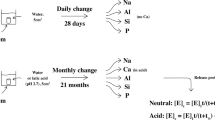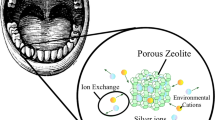Abstract
Restorative grade glass-ionomer cement has been studied for its potential as a controlled release material for the antimicrobial compound sodium fusidate. Sodium fusidate powder was incorporated into the cement at the mixing stage at levels of 1% and 5% by mass, and disc shaped specimens (6 mm diameter × 2 mm depth) prepared. After curing for 1 hour at 37°C, specimens were placed in water and release of sodium fusidate at set time intervals determined using reverse-phase HPLC. Sets of five specimens were used in all experiments. Early release of sodium fusidate was shown to occur by diffusion for each level of addition, as shown by Mt/M∞ being linear with respect to √time in both cases. Diffusion coefficients were calculated as 4.4 × 10−8 cm2 s−1 and 3.0 × 10−8 cm2 s−1 for 1 and 5% respectively. These were an order of magnitude lower than had been found previously for water transport in glass-ionomer cements, a result that is attributed to the greater size of the sodium fusidate molecule compared with that of water. Cements released 20.4 and 22.8% respectively of the total sodium fusidate added after 2 weeks, values which were not significantly different from each other, and which exceeded total release previously reported for benzalkonium chloride and chlorhexidine.




Similar content being viewed by others
References
Mount GJ. Color Atlas of glass-ionomer cements. 3rd ed. London: Dunitz; 2002.
Algera TJ, Kleverlaan CJ, de Gee AJ, Prahl-Andersen B, Feilzer AJ. The influence of accelerating the setting rate by ultrasound or heat on the bond strength of glass ionomers used as orthodontic bracket cements. Eur J Orthodont. 2005;27:472–6.
Friedman S, Löst C, Zarrabian M, Trope M. Evaluation of success and failure after endodontic therapy using a glass ionomer cement sealer. J Endodont. 1995;21:384–90.
Jonck LM, Grobbelaar CJ. Ionos bone cement (glass ionomer): an experimental and clinical evaluation in joint replacement. Clin Mater. 1990;6:323–59.
Babighian G. Use of a glass ionomer cement in otological surgery. A preliminary report. J Laryngol Otol. 1992;106:954–9.
Brook IM, Hatton PV. Glass-ionomers: bioactive implant cements. Biomaterials. 1998;19:565–71.
Nicholson JW. The chemistry of glass-ionomer cements. Biomaterials. 1998;19:485–94.
Boyd D, Towler M. The processing, mechanical properties and bioactivity of zinc based glass ionomer cements. J Mater Sci Mater Med. 2005;16:843–50.
Ellis J, Anstice HM, Wilson AD. The glass polyphosphonate cement: a novel glass-ionomer cement based on poly(vinyl phosphonic acid). Clin Mater. 1991;7:341–6.
Xie D, Chung I-D, Wu W, Lemons J, Puckett A, Mays J. An amino acid modified and non-HEMA containing glass-ionomer cement. Biomaterials. 2004;25:1825–30.
Crisp S, Pringeur M, Wardleworth D, Wilson AD. Reactions in glass ionomer cements: II. An infrared spectroscopic study. J Dent Res. 1974;53:1414–9.
Zainuddin N, Karpukhina N, Hill RG, Law RV. A long-term study on the setting reaction of glass ionomer cements by 27Al MAS-NMR spectroscopy. Dent Mater. 2009;25:290–5.
Kydonieus A, editor. Treatise on controlled drug delivery. New York: Marcel Dekker; 1991.
Palmer G, Jones FH, Billington RW, Pearson GJ. Chlorhexidine release from an experimental glass ionomer cement. Biomaterials. 2004;25:5423–31.
Botelho MG. Compressive strength of glass ionomer cements with dental antibacterial agents. J South African Dent Assoc. 2004;59:51–3.
Botelho MG. Inhibitory effects on selected oral bacteria of antibacterial agents incorporated in a glass ionomer cement. Caries Res. 2003;37:108–14.
Verbist L. The antimicrobial activity of fusidic acid. J Antimicrob Chemother. 1990;25(Supplement B):1–5.
Menday AP, Marsh BT. Intravenous fusidic acid (‘fucidin’) in the management of severe staphylococcal infections: A review of 46 cases. Curr Med Res Opin. 1976;4:132–8.
Crank J, Park GS. Diffusion in polymers. London: Academic Press; 1968.
Nicholson JW, Czarnecka B. Kinetic studies of water uptake and loss in glass-ionomer cements. J Mater Sci Mater Med. 2008;19:1723–7.
Acknowledgements
We thank Mrs Devyani Amin and Miss Samantha Booth for their assistance and advice with the experimental work.
Author information
Authors and Affiliations
Corresponding author
Rights and permissions
About this article
Cite this article
Mulla, Z., Edwards, M. & Nicholson, J.W. Release of sodium fusidate from glass-ionomer dental cement. J Mater Sci: Mater Med 21, 1997–2000 (2010). https://doi.org/10.1007/s10856-010-4060-2
Received:
Accepted:
Published:
Issue Date:
DOI: https://doi.org/10.1007/s10856-010-4060-2




